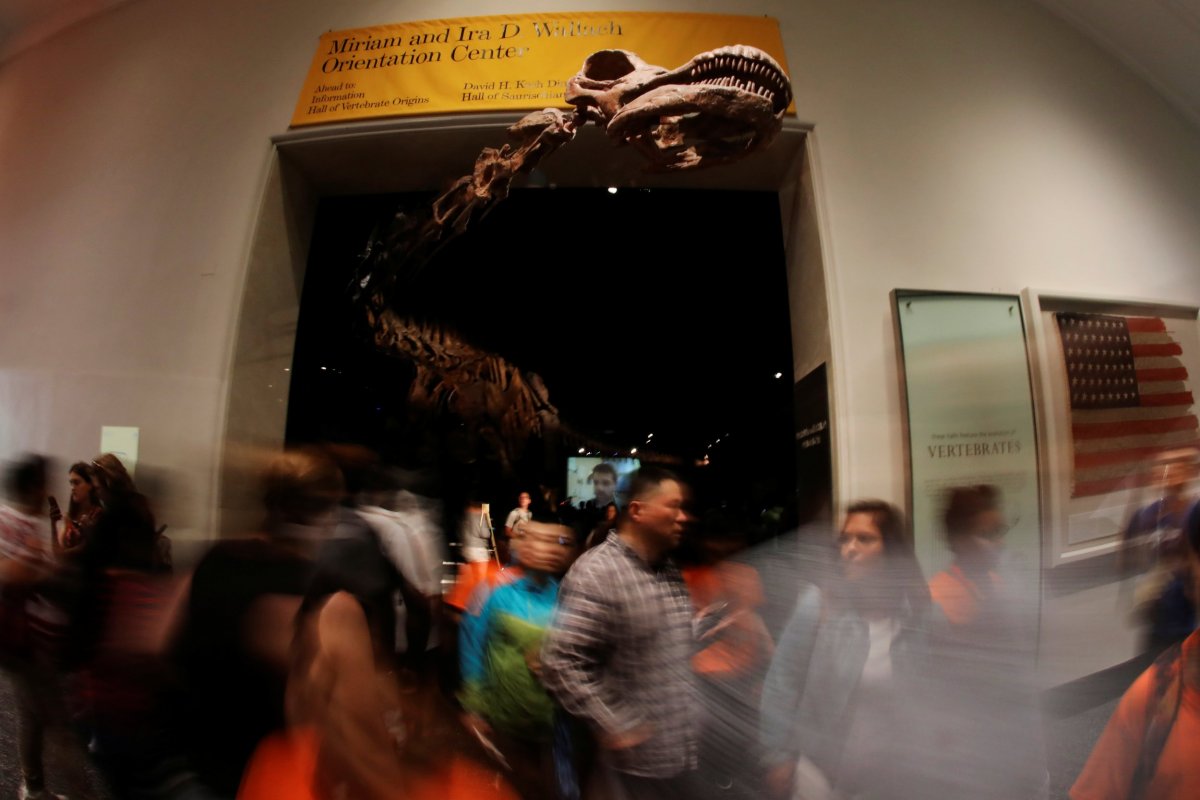
From Cassini to CRISPR to the Larsen C Ice Shelf to the Great American Solar Eclipse—2017 brought with it some of the most compelling science news. And many of the stories that topped headlines were visually memorable, which is precisely what one wants in a Halloween costume.
Thankfully, Newsweek's science desk has been keeping track all year. We've compiled a list of some of this year's most epic moments in science and medicine with tips for how to turn these stories into a perfect Halloween look. No fake news here, so save your Zombies for the apocalypse.

The Great American Eclipse: This is a stellar couple's costume option. On August 21, a solar eclipse passed over the United States, from Oregon to South Carolina. It was, unquestionably, one of the biggest events of the summer. Anywhere between 1.8 and 7.4 million people may have traveled to the path of totality to see the eclipse in all its glory, according to Michael Zeiler, a geographer who ran GreatAmericanEclipse.com. Even more people watched the eclipse online and on social media. At least 90 million people visited NASA's website that day, crushing all previous traffic records for the agency's online presence, and 66 million people posted about the eclipse on Facebook. This costume will be reusable: Another solar eclipse will pass through North America in 2024.
What you'll need: At minimum, you'll require one black outfit, one yellow outfit, and a partner—ideally, one who won't fight you over your celestial body of choice. WikiHow has some good step-by-step instructions for a homemade cardboard sun costume that could easily be adapted for a moon in the sun's shadow. Add a flashlight to complete the sun's ensemble and have the "moon" wear eclipse glasses for maximum effect. Carry a globe around or recruit a third person to be the Earth if you're feeling particularly dedicated to scientific accuracy. —Kate Sheridan
CRISPR-Cas9: This year marked some major milestones for the controversial gene-editing technology. In early August, a team of scientists at Oregon Health and Science University published a paper that showed they were able to alter a human embryo to prevent a genetic heart condition. The controversial study prompted some heated debates about the bioethics of tinkering with human DNA, and others expressed fears that this breakthrough will bring humanity closer to a future that includes designer babies.
Not long after that, another team of researchers affiliated with Harvard Medical School used these so-called molecular scissors to edit a virus out of a pig cell line, and then breed piglets with organs that potentially could be used for xenotransplantation to address the human donor organ shortage.
What you'll need: To start, something that could resemble a DNA double-helix strand. You can fashion it from wires or a Christmas tree garland. If that's too much trouble, it's relatively easy to find a silk-screened T-shirt online (or you can draw one on your own). You'll also need a pair of scissors. (Be careful while trick-or-treating. You don't want your Halloween to turn into a nightmare IRL.) Optional: an attractive baby doll to remind your friends of the horrors of eugenics. —Jessica Firger

Cassini: This spacecraft launched in 1997 and spent 13 years orbiting Saturn, but it only truly stole America's heart when we all realized it would one day be gone. That day came on September 15, when Cassini melted away in Saturn's upper atmosphere to make sure we didn't contaminate potentially habitable moons. Before its end, the mission took countless stunning images of other worlds, and scientific discoveries are slated to continue based on its data.
What you'll need: Wrap yourself in thermal blankets, strap a peanut-butter-cup-shaped probe to your side, and wear a large funnel-shaped radio dish on your head. More tips available here and here. Optional: models of Saturn and some of its 62 moons. — Meghan Bartels

Patagotitan: Ranchers discovered the world's largest dinosaur in 2014, but it wasn't formally named until 2017. Patagotitan mayorum is the only animal in its genus, and its skeleton takes up a whole gallery room in New York's American Museum of Natural History. The specimen of this long-necked dinosaur is 121 feet long, and each of its legs are taller than a human being.
What you'll need: Gaining 76 tons would be the best way to capture the Patagotitan's essence, but that can be challenging to achieve just a week before Halloween. There are many generic "dinosaur" costumes that you can buy online that include thick tails and spines down the back. To complete the long-neck look, get this Brachiosaurus mask. It's not the same as the Patagotitan, but it's probably the closest you'll get, and stylized costumes aren't always spot-on with the details. They're both sauropods, anyway. — Kristin Hugo

March for Science Activist: The mass demonstrations held on Earth Day in April drew thousands of people in cities all over the U.S. and worldwide. Scientist, doctors and anyone else who supports evidence-based research and medicine and eschews alternative facts held clever handmade signs and chanted about the EPA and President Trump's tiny hands stealing all of the petri dishes.
What you'll need: Protest-sign materials (poster board, packaging tape, markers, paint stick), white lab coat. Optional: stethoscope, nerdy glasses. —Jessica Firger

Coral Bleaching: For almost the entirety of the last two years, coral reefs around the world have been bleaching. That means that, due to warming, they are expelling the algae that keeps them colorful, turning white, and dying.
What you'll need: To dress as bleached coral, first you need to make a coral costume, then paint it white. There are many different species of coral with different shapes, but the most iconic would be some sort of wavy tubes. One approach to a bleached-coral costume would be to get a bunch of pool noodles and attach them to your clothing. You can spray-paint them white and put them on your shoulders. You may want to add some aquatic accessories like seahorses and sea-star jewelry to drive the nautical point home. — Kristin Hugo
Larsen C Ice Shelf: Sometimes things fall apart slowly—and sometimes things just snap. A huge chunk of the Larsen C ice shelf finally gave in this July, when a piece of ice infamously the size of Delaware broke off Antarctica after two years of gradually slipping away. Hey, buddy, we've all been there—we understand.
What you'll need: Lots of anything white or very pale blue to wrap around yourself—consider construction paper or the wide paper rolls available at some craft stores. Shed some of it as you go to mimic the icebergs that broke off the floating wreck. Bribe a friend your size to dress as Delaware and come prepared with other attempts to convey the breakway iceberg's more than 2,000 square miles to people. Optional: A stuffed penguin looking a little lost. — Meghan Bartels
Uncommon Knowledge
Newsweek is committed to challenging conventional wisdom and finding connections in the search for common ground.
Newsweek is committed to challenging conventional wisdom and finding connections in the search for common ground.
About the writer
Jessica Firger is a staff writer at Newsweek, where she covers all things health. She previously worked as a health editor ... Read more
To read how Newsweek uses AI as a newsroom tool, Click here.






